|
Discussing relationships is an important part of the sexuality education I teach. Young people are always eager to discuss the different social norms and expectations. It is also a topic that most parents approach with trepidtation. I have just watched this instructional video from 1951 about "what to do on a date"... 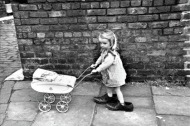 I viewed this video with a smile on my face, sighs of "how sweet" and thoughts of how lovely and simple things were back then.... Back to reality: there were just as many nerves and broken hearts as there are now. Teen pregnancy was common, it was just hidden in barbaric ways. Or young people were forced into marriages they didn’t want. Sexually transmitted infections were present, they were just hugely stigmatised and rarely treated. The risks of heartbreak, pregnancy and disease that were present in 1951 are still there now, but nearly fifty years on, these risks are magnified and that 'benchmark' age when children are exposed to these risks is becoming ever-lower. The concept of childhood is becoming increasingly short. - in 1951 the marketing concept of 'tween' had not been invented. The behavioural expectations of late-teens in 1951 are the behavioural expectations being thrust upon our pre-teens now. The tween phenomena has children wearing makeup, high-heels and parents taking them along to waxing salons. They hear it on TV, YouTube and social networking sites. This sexualisation of our children naturally leads to an early curiosity about sex and relationships. In order to be prepared for these pressures it is crucial that our young people are able to make safe decisions that will keep them happy and ensure their well-being. They need their parents support in this. More than ever, parents need to have the knowledge and confidence to be able to discuss sexuality and relationships with their children. Many parents say to me “oh but my child has no interest/no idea/no awareness about anything to do with sexuality.” This may be true, but their classmates are, and their classmates are talking. I posit it to the parents: if your child is not talking to you, they are talking to someone else and getting their information from them. What would you prefer? It’s never too early to start this ongoing conversation: make sure you don’t leave it a moment longer.
2 Comments
Thanks to Dannielle Miller for pointing me to this video. A powerful statement on the media's portrayal of women. It sent chills down my spine and tears to my eyes. 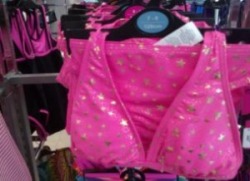 I love playing dress-ups; putting on a costume and becoming someone else for a while. As a girl, I remember finding great delight stomping round the house in Mum’s high-heels, her flowery skirts billowing up under my arms and beads trailing on the floor. Sometimes we’d pull on her old swimsuits and sarongs and pretend to be ladies at the beach. We were playing: we knew that those clothes weren’t little girls’ clothes. But the line between women’s fashion and girls fashion is blurred these days as the fashion industry has realised that young children are ripe targets for their marketing. The ‘girls’ fashion’ industry has boomed and has resulted in girls’ fashion simply being smaller sized versions of what teenagers and women are wearing. At face value, this doesn’t seem something we need to be concerned about. However when this means that lacy lingerie, sexy jeans and high heels are now seen in the ‘girls’ clothes section, I feel horrified. Yesterday, UK clothing chain store Primark withdrew from sale its range of padded bikini tops for girls as young as seven, following widespread criticism and outrage. The $4 bikini sets have been available in candy pink with gold stars and black with white polka dots. (Side note: Why do pre-pubescent girls need to wear bikinis anyway? In Europe I noticed most girls in similar swimming attire as boys until puberty – this made sense to me). Primark has apologised to customers for "causing offence" and said it would donate profits to a children's charity. The company refused to discuss the bikini's padding but an anonymous source “familiar with the product said the extra fabric was designed to preserve a girl's modesty and prevent any signs of a developing breast from showing through”. ‘Preserve a girl’s modesty’!!! What an oxymoron. By tying a padded bra on them? Need I say more. Even more saddening, this comment furthers the attitude that somehow girls developing bodies are somehow shameful. A number of UK politicians have condemned Primark for stocking such a bikini and several people have referred to the bikini as the “paedo-bikini.” But this phrase seems to be implicating girls for the behaviour of paedophiles, which in turn minimises the blame on the perpetrator. Girls and the clothes they wear are not to blame for paedophilia: paedophiles are to blame for paedophilia. As the American Psychological Association (2007) report on the sexualisation of girls stated, "If girls purchase - or ask their parents to purchase - products and clothes designed to make them look physically appealing and sexy, and if they style their identities after the sexy celebrities who populate their cultural landscape, they are, in effect, sexualising themselves." Mumsnet (UK) have launched a Let Girls Be Girls campaign. This campaign asks retailers to pledge not to sell products that prematurely sexualise children. They have an excellent list of reasons why we all should be worried about the sexualisation of girls clothing:
The upside to the Primark bikini debacle is that the media outrage has been universal. No one is suggesting that on any level are these bikinis acceptable. Let's take this opportunity to take a stand against the companies marketing sexualised clothing. On a personal level let's ensure that we all consciously clothe our children: they are children and they don't deserve to be sexualised. 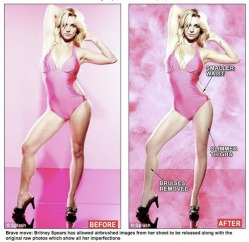 Britney Spears It’s not often (ever?!) that I am heard uttering the words “Good on you Britney”, but today, I think Britney Spears has done good. She agreed to let the UK's Daily Mail release un-airbrushed images of herself next to the digitally-altered versions. They say "the 29-year-old singer made the extraordinary move in order to highlight the pressure exerted on women to look perfect". I spent some time looking at these photos, comparing the 'before' and 'after' shots and am amazed at how extensively every blemish and "not perfect" aspect is corrected. The dry skin is covered, the bruises are banished. Even Brit's muscles have been smoothed over and 'minimised', and the *ahem* 'camel toe' dealt to. With glossy magazines and bill boards taunting women with impossible beauty it is great to actually see the full extent of how we are being deceived by the use of digital enhancement. On a conscious level, I know that most magazine and advertisements featuring scantily clad women are airbrushed. On a subconscious level, I still find myself marvelling at the petite bottoms, incredibly long legs and flawless bellies. I am long past aiming for such “flawless perfection” and have even come to love my belly that always has and always will have a slightly-pregnant pose to it. But as a teenager facing these billboards and glossy pictures, I remember having such a distorted view of my body. At 14, I went bikini shopping and spent hours in front of shop mirrors in countless numbers of size 8 bikinis grabbing every piece of “fat” (read: skin fold), only to finally conclude that I was definitely too fat to wear a bikini and went home empty handed. It makes me sad to think that I, age 14, incredibly fit and swim training up to 16 hours a week, was so sucked in by the media portrayal of ‘beauty’ to think of myself as too fat to wear a bikini. (But it also makes me smile when I throw on my a-few-sizes-bigger-than-an-8 bikini now!) My heart goes out to the girls growing up now, in a society so much more saturated by mass media and commercialism than it was in my childhood. Countless studies have shown a direct link between the media’s portrayal of beauty and body image disorders such as bulimia and anorexia. These disorders are increasing at a disturbing rate. We need to get real about the unrealistic images of “beauty” that are so prevalent in the media. So I thank you Britney for showing the world that in fact you do have dimply thighs. You don’t have a concave belly or shiny skin and you even get bruises on your legs like the rest of us. I hope more celeb’s follow suit. In fact, I hope this starts the tide of people demanding that we see REAL people in our magazines and advertisements. Getting rid of digital enhancement is an unrealistic request, but what I want to see alongside all future airbrushed images is a statement like this: “This woman’s body has been digitally enhanced. She really has dimply thighs, a cute sticky-outy belly and a small scar on her knee, but we were worried you wouldn’t buy our product if you saw those humanising features” 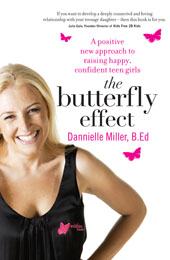 To be an effective educator, I need to be constantly learning, so an important part of ‘what I do’ is reading. People often ask me for book recommendations, and I like to be able to help out here – we are all busy people, if I can help people short-cut the path to some fabulous resources, then that makes me happy. I have recently read an wonderful book by an inspiring Australian woman, Danielle Miller. Miller’s passion is “to empower girls to grow into the bright, shiny adults they have the potential to be”. She is the founder of Enlighten Education, an organisation that offers workshops to girls in New Zealand and Australia promoting self-awareness, esteem, communication and acceptance. So much media attention is directed towards the downfall of youth today and the pressures and dangers present in the lives of our children. In moments of rage directed at soul-destroying music or childhood-ruining marketing, I have been heard to announce, “Right, that’s it. We’re running away to an isolated commune with no access to all this!”. But I don’t run away: I fight. (In the most positive non-aggressive way of fighting!). These moments of rage are why I am doing what I am doing. But I know that as a parent, it is easy to become despondent. And that’s exactly why I love Miller’s new book, 'The Butterfly Effect'. It brings me back to how we can all make a stand against the sexualised, commercialised, celebrity-focussed, fake barrage of images and noise thrust at our children. ‘The Butterfly Effect’ is a captivating book, offering a positive approach to raising girls. The challenges and pressures faced by girls and their parents are explained and backed up with research as well as Miller’s own extensive experience. But far from adopting an ‘end of the world’ approach, Miller breaks down the different aspects of raising girls, and provides realistic solutions and advice. The book emphasises the impact of women as role models – particularly with regards to body image and diet. With the prevalence of eating disorders amongst our girls increasing at a disturbing rate, this is something that all women need to consider. How can your daughters/nieces/granddaughters learn to accept their bodies when the women in their lives are constantly dieting and are so critical of their own? Miller’s approach to raising happy and empowered girls is based on forging deeper, more loving relationships – in Miller’s words: “When working with teenagers, it is important to engage them emotionally; if you can capture their hearts, their minds will follow.” I thoroughly enjoyed reading this book, a book that kept me up far too late at night because I didn’t want to put it down. If you have girls, this is a book you simply must read. “What do you do?”
I lose track of how many times I am asked this in a week. Maybe it has always been so, but I think previously my answer to this has been somewhat simpler, so I hadn’t noticed the regularity to which I was asked this. At various times I have answered with: I am studying. I am a management consultant. I am a recruitment consultant. I am a children’s party fairy. I am a surf lifeguard. I am a traveller. I am a counsellor. I am a teacher.I am trying to decide what I am going to be when I grow up. But now, “what I do” is so much harder to define. A man asked me this question on Sunday. I mentioned a couple of things that I “do”, at which point he interrupted and said he didn’t need my CV. I was a little taken aback – I had only just started! : ) I think that for this man, the question was a superficial nicety, he didn’t really want to know. Particularly once I had uttered the word ‘sexuality’... But it got me thinking – can I sum up “what I do” in a short, concise socially acceptable sentence? I thought long and hard, and decided “no”. But I did think that it was a good topic for a blog post. I am just getting started in the blogosphere and I thought it would be apt to define “what I do” at this early stage. First and foremost, I am a mother. This is my most important role and the one that will always take priority – for the rest of my life. This is my grounding principal and I will never apologise to anyone if this role interrupts other things I am ‘supposed’ to be doing. Being a mother is a huge privilege and my child only has one of me. (NB. The value our society places on this role is a whole post in itself, coming soon!) I provide education around sexuality - I teach in schools, I run workshops for parents and youth. I want every person to love, value, respect and understand their whole body. I write. I am currently writing for Birthright NZ, redeveloping their website and increasing their profile. I love it that my work will help and raise awareness of the fantastic job that so many one-parent families are doing around the country. I educate and empower local business women with their online presence and run workshops on social media. This was something that evolved, rather than a conscious decision to get involved in this area. It is so rewarding to see women who had shied away from such things become confident and innovative online networkers. I mentor young women. This is a huge privilege and one of the most inspiring parts of any week. I read. Current topics of interest are body image and the media... advertising to youth... the sexualisation of children... alcohol and pregnancy... how social media can help not-for-profits and small businesses... worm farming... sustainable living. And now... I blog. Increasingly so. My goal is three posts a week. Help keep me honest ; ) |
AuthorRachel is a writer and educator whose fields of interest include sexuality education, gender, feminism and youth development. Archives
November 2023
Categories
All
|


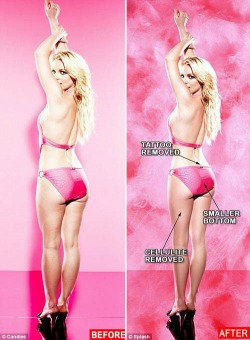
 RSS Feed
RSS Feed




